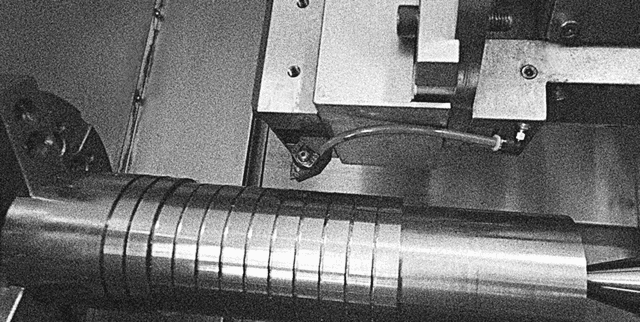CNC Turning Process Parameters and Tool Wear Data
Data Science and Analytics
Tags and Keywords
Trusted By




"No reviews yet"
Free
About
Machining data captured during CNC turning operations on AISI H13 steel, utilising cutting fluid. This collection contains detailed measurements of surface roughness, dynamic machining forces, and factors related to cutting tool wear, gathered across two distinct experimental campaigns. The data was generated as part of a Master’s Dissertation, offering valuable insights into the interdependencies between input parameters (like depth of cut and feed rate) and critical output characteristics (like surface finish and force responses). It is primarily designed for developing predictive models, such as Artificial Neural Networks, for arithmetic mean deviation ($R_a$) and other surface metrics, as well as for detailed statistical correlation analysis.
Columns
The data records several key factors and responses from the machining processes:
- Run_ID: Identification specific to each machining run.
- Experiment: Identifies the source experiment (1: Exp1, 2: Exp2, prep: preparation phase).
- Replica: The replica number for the experiment.
- Tool_ID: Identification of the cutting tool used.
- Group / Subgroup / Condition: General organisational information related to the experimental design.
- Position: The specific machined position, e.g., 'a' denotes the position farther from the chunk.
- TCond (mm): Tool condition, representing flank wear width. Levels include 0.0 mm (new tool), 0.1 mm (mid-life tool), and 0.3 mm (end-of-life tool).
- Machined_length (mm): The length of the material machined.
- Init_diameter (mm): Diameter before machining.
- Final_diameter (mm): Diameter after machining.
- CTime: Cutting time (Not applicable to Exp1 and Exp2).
- R_measurement: Angular position of the roughness measurement (separated by 60 degrees).
- ap (mm): Depth of cut.
- vc (m/min): Cutting speed.
- f (mm/rev): Feed rate.
- Ra ($\mu$m): Arithmetic mean deviation (Roughness).
- Rz ($\mu$m): Maximum height (Roughness).
- Rsk: Skewness (Roughness).
- Rku: Kurtosis (Roughness).
- RSm ($\mu$m): Mean width of profile elements (Roughness).
- Rt ($\mu$m): Total height (Roughness).
- Fx (N): Cutting force ($F_c$).
- Fy (N): Passive force.
- Fz (N): Feed force.
- F (N): Resultant force.
Distribution
The information is presented in a tabular format. The primary experiment file, Exp1.csv, consists of 27 columns and contains 324 samples, corresponding to 54 machining runs replicated twice, with roughness measured at six different locations per run. The data includes results from two major experiments (Exp1 and Exp2) and a preparation phase file (Prep.csv). Exp1 features a full-factorial design (3$^3$ levels), while Exp2 varies tool condition as an explicit factor (three levels of flank wear). Roughness parameters were sampled six times per run, while force measurements are repeated five times per condition.
Usage
This data product is perfectly suited for several analytical and predictive tasks, including:
- Building predictive models, particularly Artificial Neural Networks (ANNs), for estimating surface roughness parameters like $R_a$.
- Developing models to predict other measured roughness metrics ($R_{sk}$, $R_{ku}$, $R_{Sm}$, $R_t$).
- Modelling machining forces ($F_x$, $F_y$, $F_z$, $F$) based on turning parameters.
- Conducting statistical analysis, such as factorial ANOVA, to map correlations between experimental factors (e.g., $a_p$, $v_c$, $f$) and the measured responses.
- Research into the effects of progressive tool wear on machining outputs.
Coverage
The data collection is focused entirely on the manufacturing domain, specifically CNC turning processes.
- Material: AISI H13 steel (mean hardness = 200 HV).
- Equipment: ROMI E280 CNC turning centre, SandvikCoromant ISO TNMG cutting tools, Kistler dynamometer for forces, Mitutoyo Surftest SJ-210 for roughness.
- Experiments: Two main experiments (Exp1 and Exp2) plus a tool preparation phase.
- Time Range/Update Frequency: The data represents specific, collected experimental results and is expected to never be updated.
- Location: The data was produced in a laboratory setting at the Competence Center in Manufacturing (CCM) at the Aeronautics Institute of Technology (ITA).
License
CC BY-NC-SA 4.0
Who Can Use It
- Data Scientists and Machine Learning Engineers: For training and testing predictive models relating cutting parameters to quality metrics.
- Mechanical and Manufacturing Engineers: To understand the influence of turning parameters on surface finish and force generation in high-hardness steel.
- Academic Researchers: For studies in material removal, tribology, tool wear, and process optimization.
- Students/Educators: As a realistic, structured dataset for practical exercises in experimental design and data analysis in engineering.
Dataset Name Suggestions
- CNC Turning Process Parameters and Tool Wear Data
- AISI H13 Steel Machining Forces and Roughness
- Experimental Data for Turning Predictive Modelling
- Tool Wear Effects on CNC Turning Metrics
Attributes
Original Data Source: CNC Turning Process Parameters and Tool Wear Data
Loading...
